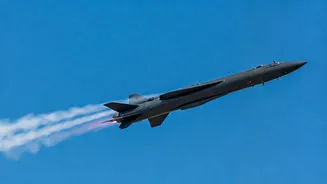A Nuclear-Powered Marvel
The Burevestnik missile distinguishes itself with its nuclear propulsion system, a feature that provides it with virtually limitless range. Conventional
cruise missiles rely on jet engines that consume fuel, thus limiting their operational scope. However, the Burevestnik's nuclear reactor empowers it to stay airborne for extended periods, enabling it to circle the globe and strike targets from any direction. The development of such a missile has been a complex undertaking. Nuclear reactors require specialized engineering and safety protocols. The integration of such technology into a missile presents its own set of challenges, including miniaturization and ensuring the reactor's safe operation throughout the flight. The successful testing of this missile suggests a substantial advancement in Russian engineering and technological capabilities, which may alter the established balance in the domain of defense capabilities and worldwide military strategy.
Strategic Implications Explored
The successful testing of the Burevestnik missile has numerous strategic implications. Its extensive range removes traditional limitations in terms of geographical constraints. This capability presents a complex strategic calculation for any nation considering military conflicts with Russia. Traditional missile defense systems, constructed to counter rockets or conventional cruise missiles, may face significant difficulties in intercepting the Burevestnik. Its ability to maneuver at low altitudes and change its flight path could hinder detection and interception. The introduction of this missile introduces the potential for a new era of strategic deterrence, affecting global power dynamics. The deployment of this type of weaponry raises questions about arms control treaties and international efforts aimed at preventing the proliferation of nuclear weapons.
International Reactions and Concerns
The announcement of the Burevestnik test has prompted reactions from multiple international entities. Various countries are now closely evaluating the implications of the new missile and its effect on regional security. Defense officials and analysts are closely examining the technical data available to assess the capabilities of the Burevestnik and to formulate appropriate defense strategies. The introduction of a nuclear-powered cruise missile is likely to intensify geopolitical tensions, particularly among nations that are in opposition or have strained relationships. It is anticipated that diplomatic discussions will be initiated to address the strategic implications of this development and explore ways to de-escalate tensions and promote stability. International organizations and arms control advocates are raising concerns about the potential for arms race and the need for stricter regulations on weapons of mass destruction.
Looking Ahead: Future Outlook
The successful testing of the Burevestnik cruise missile represents a significant turning point in military technology, and its future will be of great interest to many. In the immediate future, we can anticipate additional testing and development, which could involve improving its performance and enhancing its defense capabilities. The full deployment of the Burevestnik would be a key factor in assessing its impact on strategic stability. The long-term implications are extensive. The development of similar weapons systems by other nations could lead to a new arms race and further complicate international security issues. Diplomatic endeavors focused on establishing arms control treaties and promoting transparency in military capabilities will become vital. A clear understanding of the Burevestnik and its capabilities will be crucial for maintaining global peace and security.














